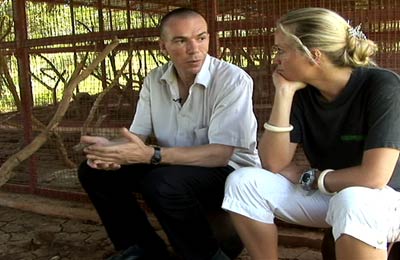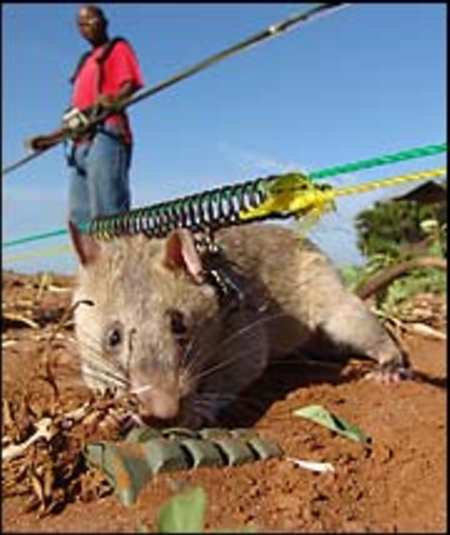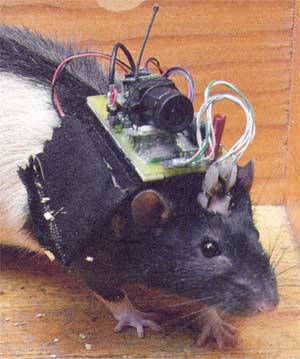
AUGUST 2007

"In the village of Malpoolenge in Mozambique, there was one mine accident near the water pit, and the whole village moved away from their homes to live in a refugee camp … In the end they only found three more mines. So, a total of four mines in the vicinity of the water pit made 25,000 people move away from their normal habitat."

As director of the Belgian APOPO de-mining operation, Bart Weetjens witnesses every day the unique abilities of the African giant pouched rat. But he also sees the lasting effect land mines can leave on communities and people. In this interview with FRONTLINE/World reporter Alexis Bloom, he talks about how one land mine incident can force an entire community to disperse. He also addresses the obstacles he faced in getting the program running and argues that rats are a misunderstood species.
Q: Alexis Bloom: Bart, how would you describe the
ideal APOPO rat?
A: Bart Weetjens: The ideal rat is one that is not too
nervous and one with an extremely keen sense of smell,
because there’s a huge variation between animals.
Not all rats are suitable to work as mine detectors. It
also has very stable behavior and interacts well with
human beings.
Q: Can you explain the process of demining and how the
rats operate?
A: The rats work in sections, 100 square meters at a
time. They are 5-by-20-meter or 10-by-10-meter boxes.
Each box takes about 25 to 30 minutes to get through. As
a comparison, a miner would be able to get through about
50 square meters a day.
Q: So when they smell that explosive in the ground,
they think they’re going to get food?
A: Yeah, they associate this particular explosive scent
with the food they want.
Q: Sort of like Pavlov’s dog?
A: Well, yes and no. It’s classic conditioning. We
associate a click sound with the food reward. Once an
animal knows that the click means food, whatever behavior
it does to get that click, it will repeat because it
knows it will get food.
Q: Couldn’t that be a problem, though? They could
just scratch randomly to get the food reward instead of
indicating the presence of explosives.
A: They don’t, though. Animals are far more honest
than humans. These rats, they’re just …
they’re nice creatures. There’s a lot of
misperception about rats. And that originates from the
Middle Ages, when rats were accused of transmitting
plague -- which is, by the way, not true. It was the
fleas on the rats that transmitted the plague, not the
rats. The rats were just victims. Of course, they do
destroy crops and do transmit diseases. But if you treat
them well and give them the proper housing and the proper
care, they are actually very organized, neat animals.
They’re very kind also, and they have very complex
social structures.
Q: With your history and training as a product
designer, where does your interest in working with mine
detection rats come from?
A: When I was a boy, I had a passion for rodents. One day
I was given a hamster, and I was so fond of this hamster
that I gave it another hamster as a playmate. Soon, I had
a lot of hamsters. And I also brought in some rats, some
gerbils, some mice -- which I kept until I was about 14
years old.
Q: How did that early interest turn into your
life’s work?
A: Well, I was working as a product engineer, designing
coaches, travel buses, and I wasn’t really happy
there. I didn’t really feel like I was contributing
to the real world. At the same time, in the ’90s,
there was this growing consciousness of the land mine
problem and the devastating consequences of land mines in
Africa. I decided that’s what I wanted to work on,
so I gave up my job and started focusing on the land mine
problem. I visited Angola and Mozambique, and I saw, for
instance in Mozambique, land mine detection groups
working with dogs. They had lots of problems with the
dogs, particularly health problems. They had brought in
20 dogs, and after three months they only had 13 left.
Seven dogs died from disease. At that moment I
hadn’t made the link yet towards rats. That happened
only after reading articles of American scientists who,
in the ’70s, had trained gerbils for the purpose of
explosive detection in airports. That for me was a match.
Of course rats could do that job.
Q. How did people respond to your idea about using
rats? Did you have to overcome prejudices?
A: Yeah, lots; in the beginning it was really tough.
Everywhere I went to apply for funding, we were just
laughed at. Most institutions were very, very reluctant
[to sponsor] such an approach. But I got support from
professors at Antwerp University. And, via the vice
chancellor, we also got access to the Development
Corporation desk in Brussels, who finally gave us a
one-year grant. Not a huge grant but sufficient for us to
start, to prove that it would be possible. With that
first grant, we imported rats from Tanzania and started a
breeding program in Belgium. The youngsters we started
making hand-tame. In the meantime, we tried out different
species of rats and all different training protocols. And
when we applied them to the African giant rat, we were
successful. After two years, we had sufficient proof to
bring the program to Tanzania and to continue developing
it with the Africans.
Q: Why did the African giant rat work? What is it
about their behavior?
A: Well, for example, when we reward them with peanuts,
they don’t eat them immediately. They keep them in
their pouches until they reach their nest box and then
bury them there to store for later. And in rainy season,
when food is plenty, they go around and collect a lot of
food in their pouches and store it underground in
burrows. Later, in dry season, when food is scarce, they
can find their way back to these stores with only their
sense of smell. So this is very close to land mine
detection.
Q: In addition to the direct detection system of
identifying contaminated areas on site, you also run a
remote tracing system. Can you tell us about that?
A: The system is called REST, for Remote Explosives Scent
Tracing, and it can hopefully speed up the whole demining
process incredibly. Let me tell you, about 95 percent of
a suspected area doesn’t contain any mines or
explosives at all. So, if you can open these areas,
already, 95 percent of the problem is resolved. In order
to do this -- and rather than going [physically]
everywhere, which takes a huge amount of time -- we have
conceived of this system, which consists of taking a
sample in an area, bringing it to the lab and letting the
rats analyze it. When several rats in a row say this
sample doesn’t contain any explosives, we can take
it for granted that the stretch of road doesn’t
contain mines, bombs and so on.
There is huge potential for quickly scanning vast road networks across Africa, which is especially important because the roads provide access to the villages. With an open road network, people can resume economic activity. So road infrastructure is essential in development, especially in Africa, where already there is a fragile infrastructure.
So say, for example, you have about 4,000 kilometers of suspected roads. If you have to clear all of these manually, it’ll take a few hundred years. This system is an attempt to find technology that can deal with the problem in a very fast way. For every 100-meter stretch, we take one sample and bring it back to the lab, so every sample corresponds with a stretch of road. The animals are actually opening the road by saying there are no explosives here; there is no danger, which is also the case in more than 95 percent of the suspected area.
Q: So you’re saying that a lot of the areas do
not have mines in them but, because a mine might have
been found one day close by, that whole area is
[abandoned -- or suspected]?
A: Yes, indeed, and there are numerous examples of it.
For instance, in the village of Malpoolenge in
Mozambique, there was one mine accident near the water
pit, and the whole village, which consisted of 25,000
people, moved away from their homes to live in a refugee
camp. It was, of course, a priority area, so it was also
cleared pretty fast. But in the end they only found three
more mines. So, a total of four mines in the vicinity of
the water pit made 25,000 people move away from their
normal habitat. So the consequences, the humanitarian
consequences, are huge.
Q: Have you ever known anybody who has lost a limb due
to a land mine?
A: Yeah, sure, in Angola even more than Mozambique. For
the moment in Mozambique, there aren’t as many
accidents anymore because the problem has been properly
met. However, in Angola, for instance, 0.5 percent of the
population -- that is, one in every 500 people -- has had
some sort of mine accident and either suffers from an
amputation or has lost a finger or eyesight. So the
impact of mines on society is huge. Being able to help
these people return to their villages and resume their
normal lives -- accessing their acres and accessing their
water sources, and just seeing that life can be normal
again -- I think that is the most rewarding motivation.
Q: Do you see other countries and peoples being able
one day to replicate this project without your expertise?
A: It is our wish that this project will replicate itself
somehow. There is already an example, though it is not on
the African continent but in Colombia. They have a huge
land mine problem, being the worst mined country in Latin
America. The Colombian police asked us a few questions
and then started a program themselves to train rats for
the purpose of land mine detection. So it is a hope and
has already begun realizing itself.
Q. What is the biggest challenge?
A: The main challenge for APOPO is to replicate this on a
huge scale. We get lots of demands from all over the
world -- Lebanon, Afghanistan, Libya, Senegal, all the
eleven Great Lakes region countries [of Africa], but also
Asian counties like Sri Lanka, Cambodia -- we cannot
comply with all these requests. We will be happy to be
able this year to start a second operation. So it's like
a drip on a hot plate. Well, not really, because what we
do makes a difference, but it goes way too slow. So if we
could make this a profitable business, owned locally and
made in a sustainable way, we could make a much bigger
impact.
**************************************************************************
Dolittle's Raiders
DAVID STIPP / Fortune 2may2005
There's a rat loose here at the Downstate Medical Center in Brooklyn, N.Y., and it's coming right at me. Suddenly it veers and goes back the way it came. Then it loops around and darts toward me again. It seems to be one dizzy rodent. But it's not. Its movements are being directed by a higher power — I'm playing with its mind by remote control.

Rat No. 3, as she's known, is wearing a tiny backpack crammed with electronics from which several wires lead into her brain through a plastic cap on her head. When I press a personal computer's cursor-control keys, radio signals are transmitted to the backpack, which in turn sends electrical impulses to the parts of her brain that register sensory input from her whiskers. Neuroscientist John Chapin and colleagues here have taught her to go left when her brain's left-whisker area is stimulated, and right upon a right-side tweak. Their training method resembles teaching a dog to roll over: When No. 3 moves as directed, they stimulate her brain's "reward" center through a third wire — like giving a treat to Rover.
The most important thing she's learning is that explosives have yummy aromas. More on that process later. But first the why: "Roborats" like No. 3 may someday be the terrorist's worst nightmare — keen, furtive little spies that can be guided into a building through, say, an air duct and then allowed to roam freely to sniff out explosives, toxic chemicals, or other bad stuff. The team at the Brooklyn center, part of the State University of New York, has even mounted tiny cameras on roborats' backs, enabling remote handlers to see where their furry operatives are going — and what they're finding.
You don't have to think very far out of the box to grasp the attractions of small, cheap, fast-reproducing animals as bomb sniffers. In recent years the Department of Defense has sought to enlist a number of nosy little creatures for the perilous job, including rats, wasps, honeybees, and even yeast (yes, yeast). The program is still a work in progress. But it has shown in fascinating detail that dogs are not the only Einsteins of olfaction, nor necessarily the best animals for nosing out explosives.
Unlike dogs, small animals can walk (or fly) over land mines without setting them off. Bees don't get hip dysplasia. Sniffer dogs need frequent rests; wasps don't. And it's a lot easier to come by insects and rodents than the purebred dogs preferred by bomb squads. In fact the market for sniffer dogs has gotten so hot since 9/11 that con artists have moved in: In 2003 the owner of a Virginia kennel was convicted of fraud after he charged federal agencies more than $700,000 for a pack of clueless pooches. In one test they allegedly failed to detect a huge cache of explosives hidden in vehicles right in front of their schnozzes. Bad dogs.
Most of the studies on non-dog sniffers have been funded by the U.S. Defense Advanced Research Projects Agency, or DARPA, an elite force permanently deployed on the border between science and science fiction. A few years ago, says Alan Rudolph, who formerly oversaw DARPA's sniffer-critter projects, it occurred to agency scientists that species whose survival has depended for millions of years on the ability to scent mates and food should have olfactory senses at least as keen as dogs'. Soon after, Rudolph, now CEO of Adlyfe, a Rockville, Md., biotech, began enlisting animal-olfaction experts to see if their favorite beasts could be taught to associate the aroma of explosives with things to which they're attracted.